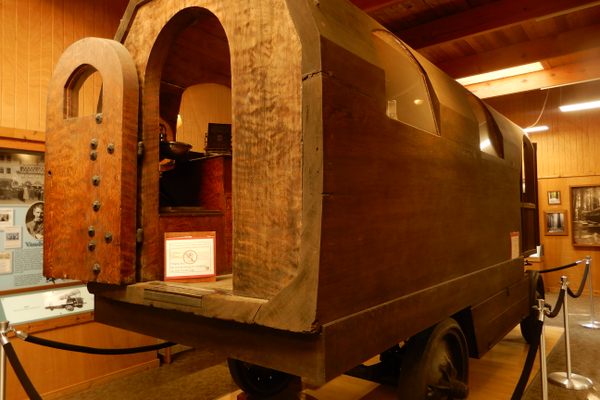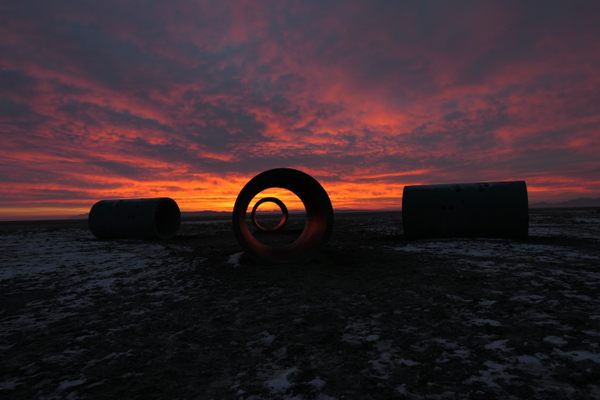Charles Kellogg Sang Like a Bird and Drove a Giant Tree
The vaudeville entertainer turned a California redwood into a mobile “Travel Log.”

The whippoorwill is often heard, but seldom spotted. This shy nightbird spends its life in the woodlands of the eastern United States, nesting on the leaf litter of the forest floor, and calling to its mate with a tremorous quirt. In the late 1910s and early 1920s, however, thousands of Manhattanites heard the whippoorwill’s call many miles away from its usual stomping grounds—at the Palace Theater, off Times Square. Yet again, the bird was nowhere to be seen. Instead, an unremarkable-looking man with a sandy mustache stood on the stage, wedged into a vaudeville variety billing of jazz singers and comedians, and whistled and trilled like a whole forest of birdsong.
It was often said that Charles Kellogg could sing like any bird he had ever heard: the halting phrases of the catbird; the trill of the cardinal; the hoot of the barred owl, and, of course, the cry of the whippoorwill, among many dozens more. Thanks to the “strange whim of nature,” the New York Times reported, he was a man born with the “throat of a bird,” with an avian syrinx as well as the normal larynx. Whether this was true or simply a canny salesman’s story has been lost to time—but what is certain is that Kellogg was a tremendous whistler. In time, his skills made him famous and wealthy, resulting in record deals, coast-to-coast tours, and repeated coverage in the national press. But it was later in his life that Kellogg put his fame to use in a way much more common to the 21st-century celebrity than those of his time: saving the environment, specifically America’s coastal redwoods.
Kellogg was born in 1869, and grew up in the wilderness of Lassen County, California. His autobiography paints a picture of a “child of nature,” a Caucasian child raised by a Native American nurse who taught him the ways of the forest. He could start fires by rubbing sticks together or, allegedly, extinguish them by singing at particularly high pitches. (Mythbusters has since tested this, and found that although it’s technically possible, it’s extremely unlikely Kellogg could have sung loud enough without amplification for it to have worked.)

As a musician, Kellogg professed to have a range of twelve-and-a-half octaves, with the highest notes inaudible to the human ear. (Mariah Carey’s range, for comparison, is just five octaves.) In one 1926 experiment, physicists recorded him singing a particularly shrill note over Radio Station KGO, then watched, amazed, as a flame went out. The Times reported that scientists later received a deluge of letters about how the sound had extinguished candles sat near the radios of listeners as far away as Hawaii.
But his skills went beyond simply mimicking the sounds of the forest. He could speak to the animals, or so he said, and claimed to have written a dictionary of the language of the hearth cricket. He was, in both his own eyes and those of his audience, “a white woods creature who could hear and see things other whites could not,” as one reporter wrote, with his upbringing lending him a certain closeness to the wilderness that he clung to for the rest of his life. Though Kellogg may have made his name as a performer, he saw himself as a scientist and a friend of nature, maintaining a vegetarian diet atypical the early 20th century, and refusing to ever carry a gun in the forest so as not to hurt its inhabitants.
In the mid-1910s, a few years into a big-ticket record contract with Victor Records, Kellogg made a pivotal trip to Humboldt County, California. This spot, some 250 miles north of San Francisco, has the largest remaining contiguous old-growth forest of coast redwoods in the world. They are trees so large it’s hard to get a handle on their scale, with girthy trunks that stretch up into foliage so far away it looks like parsley. You could host meetings inside them. The biggest among them are higher than two football fields are long, and taller than the Statue of Liberty, Big Ben, or 10 telephone poles. It is almost impossible for photographs to do them justice. Kellogg was awed.

At the time, there were no protections in place for these magnificent trees. People were logging them indiscriminately, doing irreparable harm to forests that had sat undisturbed for hundreds of years. Kellogg was swept up in a growing movement to protect them, which, since 1918, has been known as the Save the Redwoods League. In his autobiography, he describes how he found himself wondering how to show people the trees’ value, and “how to take the forest out to the world [since] the world could not come out to the forests.” In 1917, with the support of Sunset magazine, Nash Motors, and the Pacific Lumber Company, Kellogg came up with a solution. He could not take the entire redwood forest out to the world, perhaps, but there was another tangible way to communicate their tremendous size—by taking one tree on tour.

Kellogg built a mobile home out of a truck and a 22-foot section of a fallen tree that had once stood 360 feet high. A 1921 Automobile Journal article describes how the tree first stripped of its bark, then hollowed out. “The preparation of this log took weeks of time,” journalist Albert Marple wrote. “The car was fitted with windows and doors, and, inside, it was equipped with beds, kitchenette, closets, electric lights, and many other features that would add to the comfort of the travelers.” Finally, the “Travel Log” was varnished and polished, and set out on the road. For the next two years, Kellogg and his wife all but lived in the tree, traveling from California to New York with it to, as he put it, “awaken public sentiment … all over the United States.” And they had not a moment to lose: “At the present rate of destruction there will not be a single stand of redwood in the whole state within 100 years.”

It’s hard to say how much impact Kellogg’s travels had—certainly, coverage of the vehicle from the time seems to focus more on its strangeness than its message. But the redwood preservation movement that had inspired him continued to grow, eventually attracting the attention of the then-National Park Director, Stephen Mather. There was little money to be had from D.C., but media attention from such titles as National Geographic and the Saturday Evening Post found yet another way to “take the forest out to the world,” as Kellogg had done. Eventually, private donations from people including the Rockefeller family helped to secure their future: By the early 1940s, thousands of acres had been secured and safeguarded.
As the Travel Log, it retired when Kellogg did, in the 1920s, and spent the next 75 years tucked away in storage. Eventually, it was restored by the Humboldt Redwoods Interpretive Association, and put on show for all to see in the Humboldt State Park’s Visitor Center. It stands proudly in a room dedicated to Kellogg, his life, and his work—not even three miles from where it once grew for hundreds of years.





























Follow us on Twitter to get the latest on the world's hidden wonders.
Like us on Facebook to get the latest on the world's hidden wonders.
Follow us on Twitter Like us on Facebook